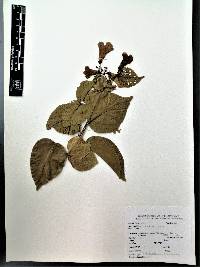
Neotropical Flora
|
Family: Bignoniaceae
|
Liana; stems terete, lenticellate, usually with interpetiolar glandular fields, puberulent when young with short white trichomes, glabrous in age; tendrils simple; pseudostipules small. Leaves 2- or 3-foliolate; petioles to 7 cm long, sparsely white-puberulent; petiolules 0.3-4.6 mm long; leaflets ovate, oblong-ovate to oval, acuminate, obtuse to rounded and sometimes inequilateral at base, 4-11 cm long, 3-5.5 cm wide, glabrate, sparsely lepidote, sometimes with a few glands near midrib below, usually drying reddish. Thyrses large, terminal or upper-axillary, pyramidal; calyx cupular, truncate, 2-5 mm long, densely tomentose, the teeth 5, minute; corolla red-violet, 2.3-3 cm long, densely tomentose outside and on lobes inside, the tube white inside, glabrous except at point of fusion of stamens just above base; stamens included, the longer pair 11-13 mm long, the shorter pair 9-10 mm long, the thecae divaricate, 1.5-2 mm long; staminodium 3-4 mm long, inserted 3-4 mm from base of corolla tube; pistil to 1.3 cm long; ovary narrowly cylindrical, finely lepidote, to 2.5 mm long. Capsules linear, to 23 cm long, ca 1 cm wide, flat, +/- verrucose, often drying reddish; valves with a raised medial vein; seeds transversely oblong, to 1 cm long and 2.5 cm wide, the wings hyaline. Croat 5038. Occasional. Flowers sporadically at the end of the dry season and throughout the rainy season, but mostly in August and September; individuals produce abundant flowers for over a month. The fruits mature principally during the dry season. Dried herbarium specimens are conspicuously reddish. Sterile live plants are difficult to recognize, but they can usually be distinguished by a combination of mostly trifoliolate leaves, narrow, dark-green leaflets, and interpetiolar glandular fields (Gentry, 1973b). |
Powered by Symbiota.












